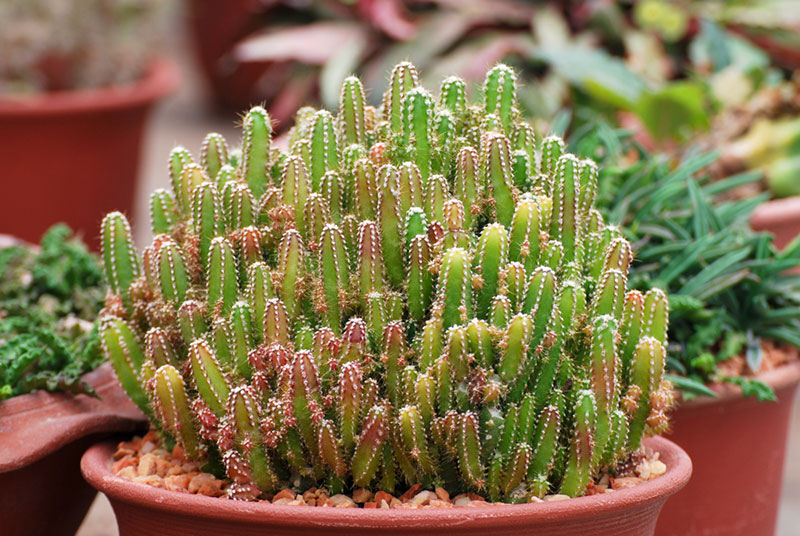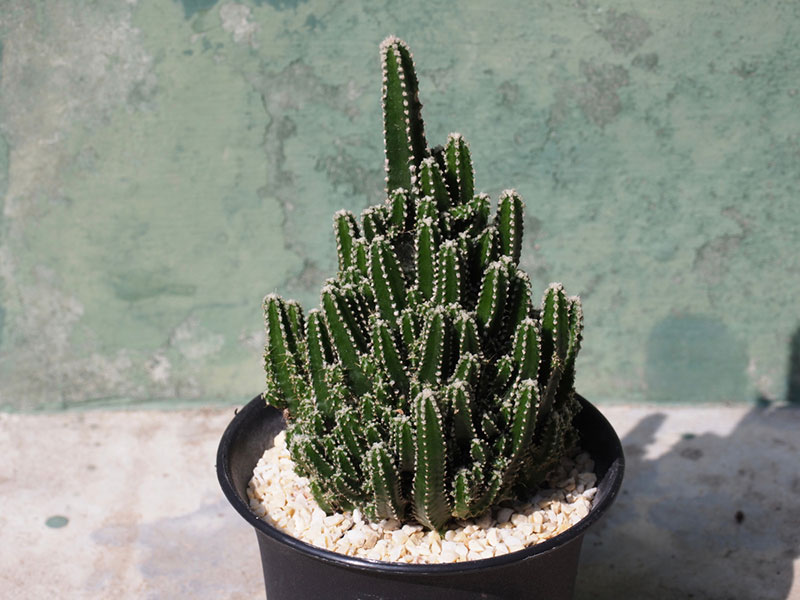
The Fairy Castle Cactus is one of the most common decorative cactus species in the nation. It is native to North, South, and Central America and can reach 6-25 feet high (1.82-7.62 meters). Getting this height indoors isn’t as likely because this plant grows very slowly and takes many years to reach that height. However, the proper care of this planet can produce a series of colorful blooms (white, purple, and pink) throughout most of the year.
Light and Temperature Requirements
The Fairy Castle Cactus does not do well in low sunlight areas. Shade, partial shade, and even partial sun will not produce the strongest or healthiest plant. Without full sun, it will fade and become misshapen. Yes, it will survive in partial shade or sun but won’t be nearly as healthy and attractive.
Position each of these plants in areas that get a lot of fun, particularly in windows on the east or west of your home. It will need at least six hours of full sun every day, so consider moving the plant if the sun shifts too much in your home. When the plant gets too big to move, you may need a UV lamp.
Growth Zones
The Fairy Castle Cactus is rated to thrive in USDA hardiness zones 10a through 11b. However, if you keep the sun exposure high and the temperature properly balanced, this plant should be fine. It can tolerate a pretty broad range of temperatures, however.
Make sure the room’s temperature is at least 70 degrees Fahrenheit (21.1 Celsius) and never gets below 32 degrees Fahrenheit (0 degrees Celsius) to prevent frost damage. The room temperature should also be below 90 degrees Fahrenheit (32.2 Celsius) to avoid damage to the spines and stems.
Watering
Succulents like the Fairy Castle Cactus don’t need a lot of water to thrive. Too much water can cause root rot and attract various bugs and other pests, like fungal infections.
Only water your cactus when the soil is completely dry. And only water the plant until the soil is damp on the surface without standing water or excessive sogginess. Cut back on watering in the winter to prevent further damage.

Soil & Fertilizing
Use a soil combined with perlite and sand (with one part potting mix) for your Fairy Castle Cactus. The oil should be well-drained and aerated with gravel and bark as well. The pot in which you plant it should be on the larger size and contain holes at the bottom for the soil to breathe.
Fertilize the soil in the spring or warmer summer months. Never fertilize your cactus after it starts going dormant in the winter. You’ll notice dormancy when the blooms start closing up for the year. Fertilizer should be rich in phosphorous and nitrogen for the best flowers. A solution of 5-10-5 is best.
Deadheading and Pruning
While the Fairy Castle Cactus is somewhat fussy about its growing conditions, it is a relatively hardy plant when adequately planted and placed in the best sun. It is considered low maintenance by most growers, mainly when planted in clay pots.
Please pay attention to symptoms of fungal infection, remove any bugs, and keep it safe in the winter. Pruning is rarely necessary with this plant, only if stems start browning.
Propagation
Propagating this plant is relatively simple, thanks to the nature of cactus species. Just about any gardener, no matter how amateur, should be able to handle these steps:
- Cut a branch from the base of the plant
- Let the wound on the cactus and stem heal in the sun
- Mix up potting soil in a well-draining clay pot, as mentioned above
- Plant the stem in the soil and place it in direct sunlight
- Water the soil to keep it moderately moist until it matures
Beyond propagation, you also need to transplant your mature Fairy Castle Cactus to a new pot every 2-3 years to help it grow smoothly and replace the potting soil with a fresh new mix.
Growing From Seed
When growing this plant from seed, make sure you place it in an glazed-free clay plot to help moisture more easily evaporate. The biggest mistake that most plant owners make is over watering their cactus, believing that it needs as much water as other plants.
Use the same kind of potting soil mentioned previously and water until you see it come out from the drainage holes. During these early years, cut your watering in half to avoid plant damage. Move your plant to the best sun windows of the house, making sure that it gets at least six (preferably more) hours of sun a day. These early years may require more sun, so make sure you are attentive to your plant.
Common Problems With the Fairy Castle Cactus
While the Fairy Castle Cactus is not prone to pest invasions or diseases, there are a few problems you may encounter. They are almost always centered on adding too much water to your cactus. Remember: these plant species are used to and need only very little water to thrive and grow.
If you add too much water, you can attract mealybugs, scale insects, bacteria, and fungus to your plant, where they’ll breed and grow in the soaked soil. Your cactus will also experience root rot because it cannot absorb this water quickly enough. And while this plant can thrive indoors, you may want to move it outside at times to get maximum sun exposure.




